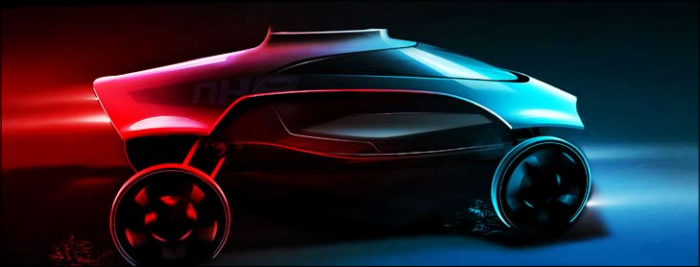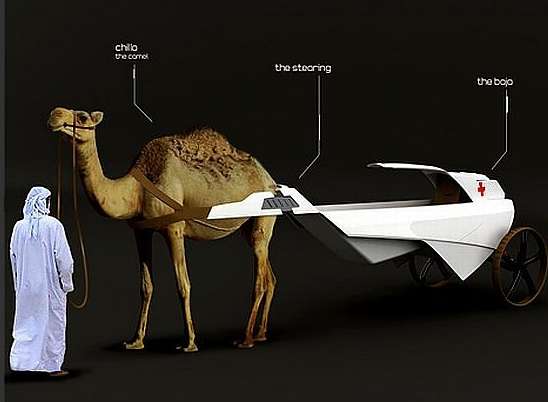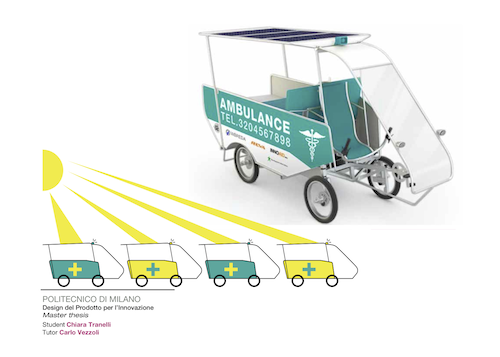Ambulance vehicles have evolved considerably since their inception in the 1800’s. These days, modern ambulance builds have to meet minimum compliance levels including, crash resistance, equipment levels, and exterior marking. But despite these compliance being in place, ambulance vehicles still face everyday challenges that hinder their effectiveness such as:
- Accessing remote places
- Driving on difficult terrain
- Maneuvering through traffic congestion
- Poor road infrastructure unsuitable for ambulance vans
- Interior space limitations
- Equipment, technology and personnel carrying limitations
In attempt to overcome the challenges that ambulances face, projects around the world are regularly coming up with new concept designs.
Here are a selection of innovative ambulance concepts, designed to adapt to the changing world we live in. Who knows, one day we may actually see an ambulance with James Bond like ejector seats!
Shell Ambulance Concept

The Shell Ambulance is designed to reflect a new type of service, which is geared towards treating people at home, rather than taking them to hospital at speed. The removable ‘shell’ can be deployed to create an expanded treatment space, or left on-scene for extended periods of time. To accommodate a range of uses the shell is interchangeable and can provide X-ray, screening and immunisation ability (source: http://www.hhc.rca.ac.uk/).
Morphing Interior Ambulance Concept

No two 999 calls are alike. The situation and condition of the patient is always different. To overcome this problem and create a safe and effective treatment space, the Morphing Interior Ambulance has a revolutionary interior, which morphs into shape. The form it takes is determined by the type of patient and subsequently the treatment they need. The soft silicone interior is combined with cuttingedge technologies, as well as versatile and ultra-thin wall mounted displays and portable video. Portable treatment packages can be accessed from inside and outside the vehicle and treatment area. This enables trained medical staff to work quickly and efficiently, for example, in a patient’s home (source: http://www.hhc.rca.ac.uk/).
Mobile Treatment Concept

Mobile treatment stations are restricted in the quanitity of kit and mix of skills that can fit on board which can sometimes restrict their medical capability. The Mobile Treatment Concept is large enough to deliver hospital treatments to remote and isolated communities. This vehicle concept has the potential to be used for delivering urgent and planned care, as well as social services and treatment programmes into the community and away from hospital (source: http://www.hhc.rca.ac.uk/).
Ladybird Concept

This agile concept deploys a temporary treatment space on-scene to enable pre-hospital clinicians to carry out time-consuming and complex treatments in the community. The rigid canopy structure protects the clinician, patient, equipment and consumables from the elements, even in the most extreme environments. The Nomad Concept is capable of driving off-road and is narrow, making it suitable for delivering care in all types of environments, such as isolated rural areas, national parks, and congested and restricted urban locations. The deployable tent is based on the Hoberman principal: it can be packaged very small and expands into a rigid dome structure instantly when deployed (source: http://www.hhc.rca.ac.uk/).
Cocoon Concept

The Cocoon Concept is modular: it is possible to adapt the configuration of the treatment space and storage capacity. This is achieved by interchanging two side ‘pods’ to suit the role of the vehicle. It is possible to customise the Cocoon during production and on base, prior to dispatch. Therefore, this concept is suitable for on- and off-road applications in remote, rural and urban settings. Pods can be designed to suit all types of urgent and emergency requirement, such as conveying to an emergency department, a treatment space, additional carrying capacity for people sitting, or lying, and additional kit and storage space. The Cocoon Concept is a unique solution for demanding environments (source: http://www.hhc.rca.ac.uk/).
Autocare Concept

Speed is of the essence in the ambulance service. The Autocare Concept aims to get the pre-hospital clinician on-scene and ready to treat the patient as quickly as possible. The design includes an ejector-type driving seat for a single clinician. The seat is activated once the vehicle is on-scene and projects the driver outside the vehicle. The seat is equipped with all the treatment packages required for the patient and deploys as a backpack with the clincian. Autocare Concept is capable of driving off-road. The vehicle width expands to accommodate rugged off-road conditions. Speedy patient loading is made possible by access through the back of the vehicle (source: http://www.hhc.rca.ac.uk/).
Mobile Treatment Space

Image sources for all of the above: http://www.hhc.rca.ac.uk/
The Mobile Treatment Space concept focuses on clinical provision in the community rather than stabilisation and transportation to hospital. A challenging and complex concept, with design requirements grouped into seven categories: diagnostic facilities, sanitation facilities, adequate furniture for treatment, suitable environment for clinical and functional use, essential drugs and gases for patient treatment, care taken over patient experience and a suitable workstation for support and administration work. These elements should all be incorporated into the design specification in order for the mobile treatment space to offer the same quality of care as an acute hospital or primary care unit (source: http://www.hhc.rca.ac.uk/).
RT112 Rescue Vehicle

Image sources: Tomasz Siemek, Behance
The RT 112 rescue vehicle concept is designed to provide emergency help even in remote parts of the world where terrain can be difficult. The project combines modern off-roading technology like adjustable air-bag suspension, a tough polycarbonate Makrolon shell and even a telescopic light tower for viewing obstacles in front of the vehicle.
Camel Ambulance – “Cambulance”

Image source: Dibhudis
On the off chance that you find yourself walking through a Desert and you get bitten by a venomous snake or stung by a poisonous scorpion, there may just be a different kind of emergency vehicle racing over the sand dunes to your rescue, a “Cambulance”.
The camel is equipped with a two-part trailer that can transport a doctor and/or patient and equipment. The main compartment called a “baja”, carries the doctor and the lightweight frame, called a “seji” is for the patient or supplies. When the doctor receives a call on his mobile phone they can plug the phone into a GPS built into the vehicle that then tracks the rig’s location once it hits the road sand. Just one small problem with this idea; it is extremely difficult to get a mobile phone signal far out in the desert!
Urban Jungle Ambulance

Image sources: Yanko Design
Traffic congestion in urban areas makes it difficult for ambulance vehicles to reach those in need quickly. The R-aid concept is an ambulance attachment capable of being pulled by a motorcycle that can quickly cut through traffic congestion and deliver medical attention to where it’s needed.Though it’s half the size of a regular ambulance van, the inside has space for a paramedic, additional driver, one secured patient, and all necessary life-saving equipment.
Mercedes-Benz SLS AMG Ambulance

Image sources: Chris Hall, Hameln, D – Ambulance photos
Unveiled at the 2011 RETTmobil Emergency Vehicle Expo, the Mercedes-Benz AMG Ambulance was specially built for Formula 1 to get wounded race drivers to the hospital as fast as possible. The ambulance is equipped with a host of communications equipment, a 6.3-liter V8 engine, Alubeam “liquid metal” paint job, gullwing doors equipped with explosive charges to blow them off their hinges if it rolls over, and a top speed of around 155mph! Any automotive enthusiast will be happy to get injured just to take a ride in this sleek ambulance.
Bengali Rural Ambulance

Image sources: Innoaid
Due to locally very bad infrastructure in the Sundarbans, India, it is not possible to find a safe means of transporting the sick to health clinics or hospitals. The Bengali Rural Ambulance Project (BeRA) focuses on addressing the lack of safe and clean means of transporting sick, injured and pregnant people in the Sundarbans, India. One student came up with a solar driven, lightweight ambulance capable of transporting medical equipment and sick people from difficult to reach areas to hospitals.
CarNurse

Image sources: Tuvie
CarNurse is a concept vehicle aimed at providing medical support for wounded people at public beaches. The vehicle offers adequate space to accommodate about seven passengers (for 3 lifeguards and 4 attendants), together with a stretcher for the injured. The car has emergency storage space at the bottom of the lifeguard’s chair and under the stretcher for medical equipments to handle critical situations.
Moreover, the concept vehicle can move both on land and in water with equal efficiency during emergency rescue operations.. If CarNurse becomes a reality then it will undoubtedly be welcomed by coastguards to help them accomplish quick and comprehensive rescue operations when needed.
Jaambaaro

Image sources: Yanko Design
Africans in rural areas often have to travel vast distances to seek medical attention and in most cases, traditional ambulances aren’t available. Made of salvaged materials, the Jaambaaro is literally a pedal-car with a stretcher, driven by two persons pedalling and assisted by electrical power generated from solar energy. Although the Jaambaaro is obviously much slower than a gas powered ambulance, it could be the only option if nothing else is available.
BMW X6 xDrive 50i Ambulance

Image sources: Wallpaperup
The BMW X6 xDrive50i Ambulance concept is powered by a 407hp twin-turbo, 4.4-litre V8 and is positioned as a first responder vehicle, which would carry a doctor or paramedic to a scene before the an ambulance arrives. It contains all the medical equipment normally found in an ambulance, as well as having side cameras in the bumpers, a rear camera and a variety of flashing blue LEDs to warn other road users of its presence.
However, the BMW X6 xDrive50i doesn’t come without it’s drawbacks. This gas guzzler averages only 22.6mpg and emits a whopping 299g/km of C02!
Related post: 11 Weirdest Ambulances of All Time
Share
Leave a Reply



